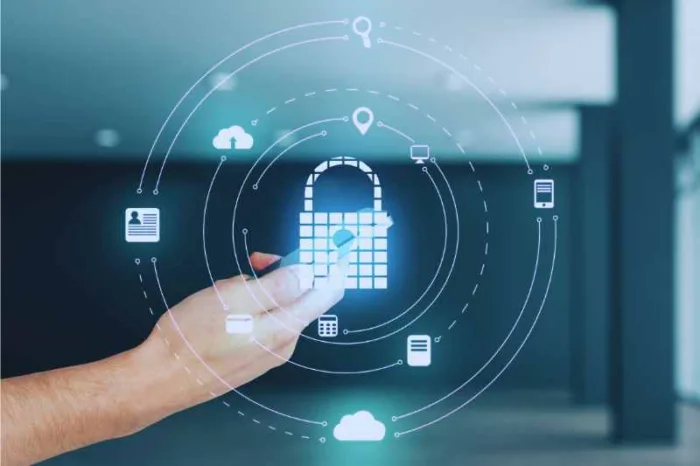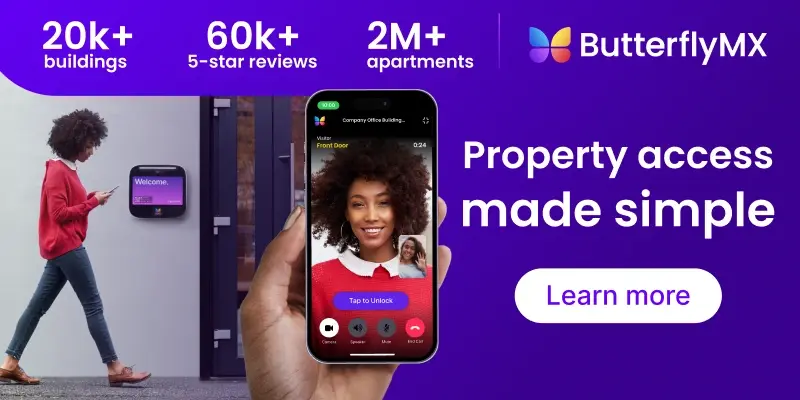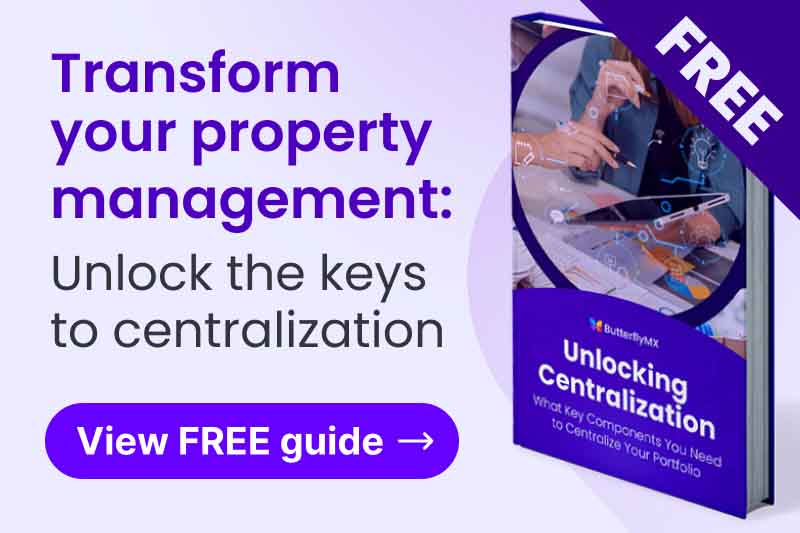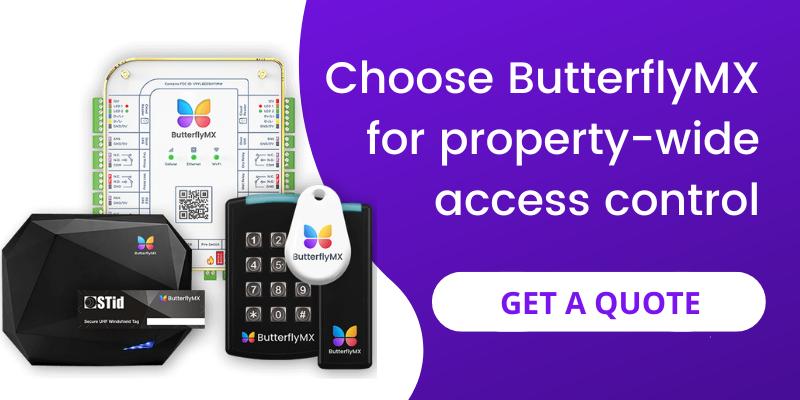Key takeaways
- Centralized access control is when you manage access to one or more of your properties from a single unified point of control.
- Benefits of centralization include improved security, cost savings, and better access management.
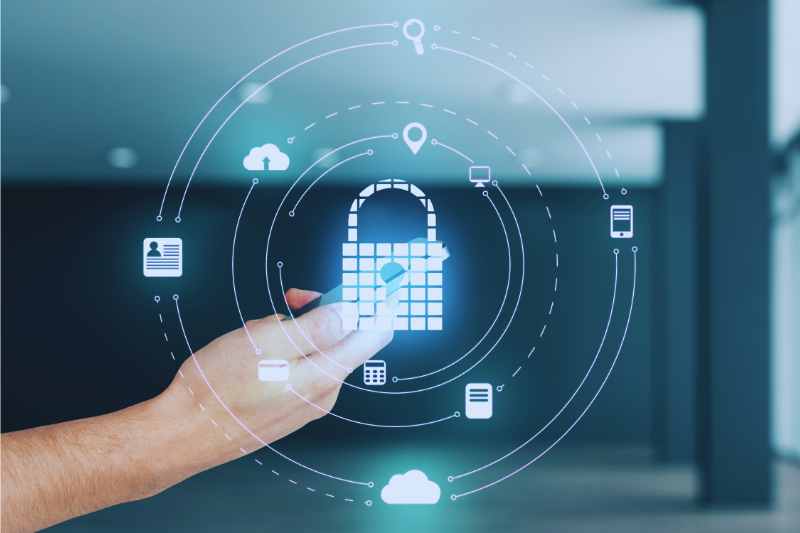
One technology that is drastically shaping property management for commercial and multifamily properties is centralized access control. This sophisticated system offers a host of benefits that can transform how properties are managed, ensuring enhanced security and operational efficiency.
In this blog post, we’ll dive into what centralization is. Next, we’ll explore the benefits. Lastly, we’ll go over the best centralized access control system to buy.
This post covers:
- What is a centralized access control system?
- What is the difference between centralized and decentralized access control?
- Benefits of access control centralization
- How to use centralized access
- The best centralized access control system
What is a centralized access control system?
Centralized access control is a system that allows property managers to manage and monitor access to a property from a single central point. Unlike traditional lock-and-key systems, which require physical keys for each door, centralized systems utilize electronic access methods such as key cards, fobs, or biometric scanners. The system is integrated with a central management console, often accessible through web or mobile applications, allowing for streamlined administration of access permissions.
What is an example of a centralized control system?
An example of a centralized control system is a smart building management platform that integrates various building systems, such as lighting, HVAC, and security, into a single, cohesive system.
For instance, a centralized access control system allows property managers to monitor and manage access across multiple entry points from one central OS console. This system uses electronic credentials like key cards or biometric scans to grant or restrict access, providing real-time data on who is entering which areas and when. This integration enhances security, streamlines operations, and improves overall management efficiency.
Discover the secrets to multifamily centralization:
What is the difference between centralized and decentralized access control?
The primary difference between centralized and decentralized access control lies in the management and administration of access permissions. Centralized access control consolidates all management functions into a single central system or console. This means that access permissions for all entry points are controlled from one location, allowing for streamlined administration, real-time monitoring, and unified reporting.
In contrast, decentralized access control distributes management responsibilities across multiple independent systems or locations. Each entry point may have its own access control system, requiring separate administration and potentially leading to inconsistencies and inefficiencies. While centralized systems offer a unified approach and ease of management, decentralized systems may be more suited for environments requiring localized control or where infrastructure limitations exist.
Is there a difference between centralized and distributed access control?
Distributed access control involves multiple independent systems managing access at different locations or entry points. Each system operates autonomously, which can offer flexibility and localized control but may result in fragmented management and potentially inconsistent security protocols. Centralized systems provide a unified and cohesive management experience, while distributed systems offer localized control and adaptability.
Benefits of access control centralization
The top benefits of centralized access control are:
1. Improved security
One of the most significant advantages of centralized access control is the enhanced security it provides. Traditional keys can be easily lost or copied, leading to potential security breaches. Electronic access systems eliminate these risks by providing a more secure method of entry. Each access credential, such as a key card or biometric scan, can be tracked and monitored, ensuring that only authorized individuals gain property access to specific areas.
Additionally, centralized systems offer real-time monitoring and reporting capabilities. Property managers can receive instant alerts for unauthorized access attempts or other security incidents, allowing for swift action to be taken. This level of oversight is crucial for maintaining a secure environment, particularly in multi-unit residential or commercial properties.
2. Streamlined operations
Manually managing access can be cumbersome and time-consuming, especially in properties with numerous units or entry points. Centralized access control simplifies this process by enabling property managers to handle all access-related tasks from a single platform. This includes issuing, modifying, or revoking access credentials, as well as scheduling access times for tenants or staff.
For example, if a tenant loses their key card or if a staff member needs temporary access to a restricted area, property managers can quickly adjust access permissions through the central management console. This eliminates the need for physical key replacement and reduces administrative overhead, ultimately saving time and resources.
Additionally, you can manage other property management tasks, including leasing renewals.
3. Improved tenant experience
A seamless and secure access system significantly enhances the tenant experience. With centralized access control, tenants can enjoy the convenience of electronic entry, which can be as simple as swiping a key card or using a smartphone app. This modern approach to access eliminates the hassle of carrying physical keys and reduces the likelihood of lockouts.
Moreover, property managers can use the centralized system to offer tenants greater flexibility. For instance, access permissions can be tailored to accommodate different needs, such as granting temporary access to guests or service providers. This level of customization ensures that tenants receive a higher level of service and convenience, contributing to overall tenant satisfaction and retention.

4. Access management
Centralized access control systems provide a high level of control over who can enter specific areas and when. This is particularly valuable in properties with restricted zones, such as storage rooms, maintenance areas, or administrative offices. Property managers can set up different access levels for various user groups, ensuring that only authorized personnel can enter sensitive or high-security areas.
Additionally, the ability to generate detailed access logs helps in tracking and managing building usage. These logs can provide valuable insights into traffic patterns, usage trends, and even potential security issues. By analyzing this data, property managers can make informed decisions about access policies and maintenance needs, further optimizing property management practices.
5. Cost savings
While the initial investment in centralized access control systems may seem substantial, the long-term cost benefits are considerable. Traditional key systems often require frequent key replacements, re-keying, and lock repairs, all of which can add up over time. Centralized access control reduces these costs by minimizing the need for physical keys and lock changes.
Furthermore, the efficiency gains from streamlined access management and reduced administrative tasks contribute to overall cost savings. Property managers can allocate their time and resources more effectively, focusing on other critical aspects of property management.
How to use centralized access
Before implementing a centralized system at your property, we recommend that you do the following:
- Assess your property’s needs. Consider factors such as the size of the property, the number of access points, and the security requirements. This assessment will help determine the appropriate system features and scale.
- Choose the right system. Look for systems that offer scalability, user-friendly interfaces, and compatibility with existing infrastructure. Key features you should consider include real-time monitoring, remote access management, and integration with other security systems.
- Work with a reputable provider. Partnering with a reputable access control provider is crucial for ensuring a successful implementation. Choose a provider with experience in the property management sector and a track record of delivering reliable and efficient systems. They can offer valuable insights, support, and maintenance services to ensure your system operates smoothly.
- Train your team. Proper training is essential for maximizing the benefits of a centralized access control system. Ensure that your team is well-versed in using the system’s features and understands how to manage access permissions effectively. Providing training and support will help prevent issues and ensure a smooth transition to the new system.
- Regularly review and update access policies. Centralized access control systems offer the flexibility to adapt to changing needs. Regularly review and update access policies to reflect changes in property management requirements, tenant needs, or security concerns. Keeping your access policies up-to-date ensures that your system remains effective and aligned with your property’s objectives.
The best centralized access control system
ButterflyMX offers the best centralized access control system. ButterflyMX is currently installed in over 10,000 buildings and has over 20,000 five-star reviews.
ButterflyMX’s centralized access control system features:
- Front Desk Station. ButterflyMX’s Front Desk Station is a visitor management software that integrates with your organization’s computer. This system allows you to stream live video to monitor building activity and manage visitors, enhancing security.
- Elevator Controls. Residents unlock key-fobbed elevators using a single mobile app, eliminating the need for multiple access credentials. This centralized control enhances convenience and streamlines entry methods.
- Top-rated mobile app. The ButterflyMX mobile app provides residents with comprehensive access management features. It includes a swipe-to-open button for touchless entry, two-way video communication for seeing and speaking with visitors, and remote access control for maintenance workers and guests from anywhere in the world.
- Amenity reservation. The ButterflyMX app enables residents to book building amenities anytime. They can check availability, view associated fees, and make reservations for themselves and their guests. Property staff can easily configure and manage amenity spaces through a user-friendly cloud-based dashboard.
- Security Cameras. The ButterflyMX Bullet and Dome Cameras give you options for remotely monitoring your property and gaining insights into daily operations.
- Package Room. The ButterflyMX Package Room simplifies package management and prevents package theft or missed deliveries. Deliveries can be securely left in the package room using a designated PIN, and residents can retrieve their packages at their convenience.
